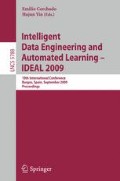Abstract
Decision trees generate classifiers from training data through a process of recursively splitting the data space. In the case of training on continuous-valued data, the associated attributes must be discretized into several intervals using a set of crisp cut points. One drawback of decision trees is their instability, i.e., small data deviations may require a significant reconstruction of the decision tree. Here, we present a novel soft decision tree method that uses soft of fuzzy discretization instead of traditional crisp cuts. We use a resampling based technique to generate soft discretization points and demonstrate the advantages of using our resampling based soft discretization over traditional crisp methods.
Access this chapter
Tax calculation will be finalised at checkout
Purchases are for personal use only
Preview
Unable to display preview. Download preview PDF.
References
Quinlan, J.R.: Decision Trees and Decision Making. IEEE Transactions on System, Man and Cybernetic, 339–346 (1990)
Breiman, L., Friedman, J.H., Olshen, R.A., Stone, C.J.: Classification and Regression Trees. Wadsworth International, San Francisco (1984)
Quinlan, J.R.: C4.5: Programs for Machine Learning. M. Kaufmann, SanMateo (1993)
Kerber, R.: Discretization of Numeric Attributes. In: Proceedings of the Tenth National Conference on Artificial Intelligence, pp. 123–128. MIT Press, Cambridge (1990)
Fayyad, U.M., Irani, K.: Multi-interval Discretization of Continuous-Valued Attributes for Classification Learning. In: Proceedings of the 13th International Joint Conference on Artificial Intelligence, pp. 1022–1027. Morgan Kaufmann, San Mateo (1993)
Efron, B., Tibshirani, R.: An Introduction to the Bootstrap. Chapman and Hall, Boca Raton (1998)
Blake, C.L., Merz, C.J.: UCI Repository of machine learning databases. Irvine, CA: University of California, Department of Information and Computer Science (1998), http://www.ics.uci.edu/~mlearn/MLRepository.html
Zadeh, L.A.: Fuzzy Sets as a bases for a Theory of Possibility. Fuzzy Sets and Systems, 3–28 (1978)
Olaru, C., Wehenkel, L.: A complete fuzzy decision tree technique. Fuzzy Sets and Systems 138, 221–254 (2003)
Ramdani, M.: System d’Induction Formelle a base de Connaissanses Impresises. These de l’universite P et M Curie, rapport 94/1, LAFORIA IBP (1994)
Wang, T., Zhoujun, L., Yuejin, Y., Huowang, C.: A Survey of Fuzzy Decision Tree Classifier Methodology. In: ICFIE, pp. 959–968 (2007)
Shannon, C.E., Weaver, W.: The mathematical Theory of Communication. University of Illinois Press, Urbana (1949)
Janikow, C.Z.: Fuzzy decision trees: issues and methods. IEEE Transactions on Systems, Man, and Cybernetics, Part B 28(1), 1–14 (1998)
Ichihashi, H., Shirai, T., Nagasaka, K., Miyoshi, T.: Neuro fuzzy ID3: A method of inducing fuzzy decision trees with linear programming for maximizing entropy and algebraic methods. Fuzzy Sets System 81(1), 157–167 (1996)
Xizhao, W., Hong, J.: On the handling of fuzziness for continuous valued attributes in decision tree generation. Fuzzy Sets System 99, 283–290 (1998)
Murthy, S.K., Kasif, S., Salzberg, S.: A System for Induction of Oblique Decision Trees. Journal of AI Research (1994)
Marsala, C.: Application of Fuzzy Rule Induction to Data Mining. In: Andreasen, T., Christiansen, H., Larsen, H.L. (eds.) FQAS 1998. LNCS (LNAI), vol. 1495, pp. 260–271. Springer, Heidelberg (1998)
Author information
Authors and Affiliations
Editor information
Editors and Affiliations
Rights and permissions
Copyright information
© 2009 Springer-Verlag Berlin Heidelberg
About this paper
Cite this paper
Qureshi, T., Zighed, D.A. (2009). A Soft Discretization Technique for Fuzzy Decision Trees Using Resampling. In: Corchado, E., Yin, H. (eds) Intelligent Data Engineering and Automated Learning - IDEAL 2009. IDEAL 2009. Lecture Notes in Computer Science, vol 5788. Springer, Berlin, Heidelberg. https://doi.org/10.1007/978-3-642-04394-9_71
Download citation
DOI: https://doi.org/10.1007/978-3-642-04394-9_71
Publisher Name: Springer, Berlin, Heidelberg
Print ISBN: 978-3-642-04393-2
Online ISBN: 978-3-642-04394-9
eBook Packages: Computer ScienceComputer Science (R0)

